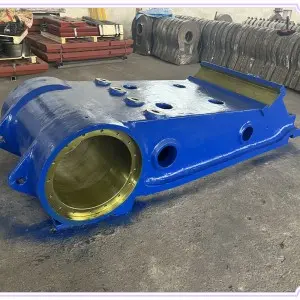During the operation of the crusher, the mandibular support (or mandibular toe) is a key supporting component, and its mechanical structure directly affects the load-bearing capacity and stability of the equipment. This article will analyze the load-bearing capacity and stability of the mandibular support from the perspective of structural mechanics, helping you better understand its importance in crushers.
First, the mechanical structure of the mandibular stent
The mandibular support is an important component of the crusher, and its design and material selection are crucial to the overall performance of the equipment. Mandibular braces are usually made of high-strength steel to ensure they can withstand tremendous pressure and impact. Its structural design usually includes multiple support points, which are distributed at the bottom of the equipment to provide uniform support force, thereby enhancing the stability of the equipment.
Second, load-bearing capacity
The load-bearing capacity of the mandibular stent depends on the strength of its material and the structural design. The use of high-strength steel can significantly enhance the load-bearing capacity of the support, enabling it to withstand the tremendous pressure generated during the crushing process. In addition, a reasonable structural design, such as increasing the number of support points and optimizing their distribution, can also help enhance the load-bearing capacity.
In practical applications, the load-bearing capacity of the mandibular support needs to undergo strict testing and verification to ensure that it can meet the operational requirements of the crusher. This includes conducting static and dynamic load tests on the support to evaluate its performance under different working conditions.
Third, stability
Stability is another important characteristic of the mandibular stent. A stable support can ensure that the crusher remains balanced during operation, reduce vibration and shaking, and thereby enhance the operational efficiency and service life of the equipment. To enhance stability, mandibular braces typically adopt a wide-bottom design to increase the supporting area and thereby lower the center of gravity of the equipment.
In addition, the connection method of the bracket also has a significant impact on its stability. Sturdy connecting parts and bolts can ensure a tight connection between the support and the main body of the crusher, further enhancing the stability of the equipment.
Fourth, considerations in practical applications
When choosing and using mandibular braces, it is necessary to comprehensively consider their load-bearing capacity and stability. For different models of crushers and application scenarios, it may be necessary to select brackets of different specifications and designs. For instance, when dealing with harder materials or larger loads, higher-strength brackets may be required.
At the same time, regular maintenance and inspection are also key to ensuring the performance of the mandibular stent. Regularly inspecting the connecting parts, bolts and support points of the support frame, promptly identifying and repairing potential problems, can effectively extend the service life of the support frame and ensure the stable operation of the equipment.
Fifth, future development direction
With the continuous advancement of technology, the design and materials of mandibular braces are also constantly evolving. The application of new high-strength materials and advanced structural design methods will further enhance the load-bearing capacity and stability of the support. For instance, the application of composite materials can offer higher strength and lighter weight, thereby optimizing the performance of the support.
In addition, the application of intelligent monitoring technology also provides new means for the maintenance and management of brackets. By installing sensors, the load and status of the bracket can be monitored in real time, potential problems can be detected promptly, and the safety and reliability of the equipment can be enhanced.
Conclusion
The mechanical structure of the mandibular stent plays a crucial role in its load-bearing capacity and stability. Reasonable material selection and structural design can significantly enhance the performance of the support, thereby ensuring the stable operation of the crusher. In practical applications, it is necessary to select appropriate brackets based on specific working conditions and requirements, and carry out regular maintenance and inspection. With the continuous advancement of technology, the application of new materials and intelligent technologies will further optimize the performance of the mandibular support, providing a more reliable guarantee for the efficient operation of the crusher.
Post time: Oct-13-2025

